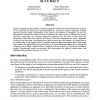Free Online Productivity Tools
i2Speak
i2Symbol
i2OCR
iTex2Img
iWeb2Print
iWeb2Shot
i2Type
iPdf2Split
iPdf2Merge
i2Bopomofo
i2Arabic
i2Style
i2Image
i2PDF
iLatex2Rtf
Sci2ools
MT
1998
1998
Bilingual Sentence Alignment: Balancing Robustness and Accuracy
Sentence alignment is the problem of making explicit the relations that exist between the sentences of two texts that are known to be mutual translations. Automatic sentence alignment methods typically face two kinds of difficulties. First, there is the question of robustness. In real life, discrepancies between the source-text and its translation are quite common: differences in layout, omissions, inversions, etc. Sentence alignment programs must be ready to deal with such phenomena. Then, there is the question of accuracy. Even when translations are "clean", alignment is still not a trivial matter: some decisions are hard to make, even for humans. We report here on the current state of our ongoing efforts to produce a sentence alignment program that is both robust and accurate. The method that we propose relies on two new alignment engines, and combines the robustness of so-called "character-based" methods with the accuracy of stochastic translation models. Exper...
| Added | 22 Dec 2010 |
| Updated | 22 Dec 2010 |
| Type | Journal |
| Year | 1998 |
| Where | MT |
| Authors | Michel Simard, Pierre Plamondon |
Comments (0)

